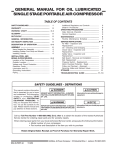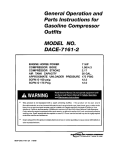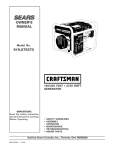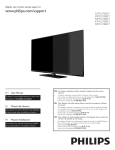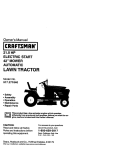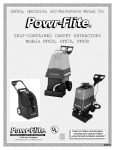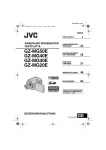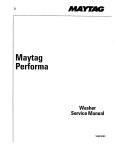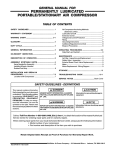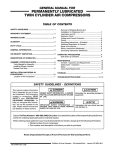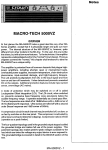Download DeVilbiss 250E20AD Generator Specifications
Transcript
50E2OAD
GENERAL
MANUAL FOR OIL LUBRICATED
SINGLE STAGE PORTABLE AIR COMPRESSOR
TABLE OF CONTENTS
SAFETY GUIDELINES ............................................
1
WARRANTY ...........................................................
2
WARNING
CHART ...............................................
3-4
GLOSSARY .............................................................
5
DUTYCYCLE ..........................................................
5
GENERAL INFORMATION ...................................
5
ON-RECEIPT INSPECTION ..................................
5
DESCRIPTION
OF OPERATION ..........................
5-6
ASSEMBLY .............................................................
Items Needed for Assembly ................................
Installing Rubber Foot Strip and Wheels ............
Installing Handle .................................................
6
6
6
6
INSTALLATION AND
BREAK-IN PROCEDURES .....................................
Location of Air Compressor ................................
Outside Location .................................................
Voltage and Circuit Protection ...........................
Extension Cords ..................................................
Lubrication and Oil ..............................................
Grounding Instructions .......................................
Piping ...................................................................
6-8
7
7
7
7
7
7
8
SAFETY
This manual contains information
that is important for you to know
and understand. This information
relates to protecting
YOUR
SAFETY
and PREVENTING
EQUIPMENT
PROBLEMS. To
he_p you recognize this information, we use the symbols to the
right. Please read the manual and
pay attention to these sections.
Additional Regulators and Controls ...................
Break-in Procedures ...........................................
OPERATING PROCEDURES .................................
Daily Start-Up Checklist .....................................
Normal Operation ................................................
8
8
8
8
8
MAINTENANCE ....................................................
Routine Maintenance Schedule ........................
9
9
SERVICE INSTRUCTIONS ..................................... 9-11
Air Filter - Inspection and
Replacement .......................................................
9
Oil - Checking and Changing .............................
9
Check Valve - Inspection and
Replacement .......................................................
9
Safety Valve - Inspection and
Replacement .......................................................
9
Belt Guard - Removal and Installation ...............
10
Belt Replacement ...............................................
10
Pressure Switch - Replacement .........................
10
Motor Overload Protector - Reset ......................
10
Pulley and Flywheel - Alignment ........................
10
Servicing Intake and Exhaust Valves .................
10
STORAGE ...............................................................
11
TROUBLESHOOTING
GUIDELINES
[ _, DANGER
- DEFINITIONS
J
URGENTSAFETYINFORMATION- A HAZARD
THATWILLCAUSESERIOUS INJURYOR LOSS
OF LIFE.
a, WARNING
GUIDE ........................... 11 - 13
]
IMPORTANTSAFETYINFORMATION
-AHAZARD
THATMIGHTCAUSESERIOUSINJURYORLOSS
OF LIFE.
_CAUTION
]
Informationfor preventingdamageto
equipmenL
NOTE
I
Informationthat youshouldpayspecia
attentionto.
Call our Toll Free Number 1-800-888-2468, Ext 2, then 1, to obtain the location of the nearest Authorized
Service Center for ordering repair parts and for warranty repairs.
When ordering repair parts from your local Authorized Service Center, always give the following information:
• Model number of your compressor
• Part number and description of the item you wish to purchase
Retain Original Sales Receipt as Proof of Purchase for Warranty Repair Work.
DeVilbiss Air Power Comp;
MG3-OLPORT-3A
11/6/98
ONE
YEAR
LIMITED
FROM
WARRANTY
DATE OF PURCHASE
All merchandise manufactured by DeVilbiss Air Power Company/ExCell Manufacturing is warranted to be free of
defects in workmanship and material which occur during the first year from the date of purchase by the original
purchaser (initial user). Products covered under this warranty include: air compressors, *air tools, accessories,
service parts, pressure washers, and generators used in consumer appficafions (i.e., personal residential
household usage only).
Air compressors,
*air tools, accessories,
service parts, pressure washers,
applications
(income producing)
are covered by a 90 day warranty.
and generators
used
in commercial
DeVilbiss
Air Power/ExCell
Manufacturing
will repair or replace, at DeVilbiss/ExCell's
option, products
or
components
which have failed within the warranty period. Repair or replacement,
and service calls on 60 and 80
gallon air compressors,
will be handled by Authorized
Warranty Service Centers and will be scheduled and
serviced according to the normal work flow and business hours at the service center location, and depending on
the ava#ability
of replacement
parts.
All decisions of DeVilbiss Air Power Company/ExCell Manufactudng with regard to this policy shall be final.
This warranty gives you specific legal rights, and you may also have other rights which vary from state to state.
( RESPONSIBILITYOF
ORIGINAL PURCHASER
(Ini_al User): J
{3
[3
Q
Retain onginal cash register sales receipt as proof of purchase for warranty work.
Use reasonable care in the operation and maintenance of the product as described in the Owners Manual(s)•
Deliver or ship the product to the nearest DeVilbiss Air Power/ExCell Manufacturing Authorized Warranty
Service Center. Freight costs, if any, must be paid by the purchaser.
[3 Air compressors with 60 and 80 gallon tanks only will be inspected at the site of installation. Contact the
nearest Authorized Warranty Service Center, that provides on-site service calls, for service cell arrangement.
[3 If the purchaser does not receive satisfactory results from the Authorized Warranty Service Center. the
purchaser should contact DeVilbiss Air Power Company/ExCell Manufacturing.
(THIS
[3
O
[3
WARRANTY
DOES NOT COVER:J
Merchandise sold as reconditioned, floormodels and/or display models. Any damaged or incompleteequipment
sold "as is".
Merchandise used as "rental" equipment.
Merchandise that has become inoperativebecause of ordinarywear, misuse, freeze damage, use of improper
chemicals, negligence, accident, improperand/or unauthorizedrepair or alterationsincluding failure to operate
the product in accordance with the instructionsprovided in the Owners Manual (s) supplled with the product.
*Air Tools: O-Rings and driver blades are considered ordinary wear parts, therefore, they are warranted for a
period of 45 days from the date of purchase.
An air compressor that pumps air more than 50% during a one hour period is considered misuse because
the air compressoris undersized for the required air demand. Maximum compressorpumping time per hour is
30 minutes.
[3
Merchandise sold by DeVilbiss Air Power/ExCell Manufacturing which has been manufactured by and identified
as the productof another company. The product manufacturers warranty will apply.
[3 Repair and transportationcosts of merchandise determined not to be defective.
_1 Cost associated with assembly, required oil, adjustments or other installationand start-up cost.
[3 ANYINCIDENTAL, INDIRECTORCONSEQUENTIAL LOSS, DAMAGE, OR EXPENSETHATMAYRESULT
FROM ANY DEFECT, FAILURE OR MALFUNCTION OF THE PRODUCT. Some states donotallowthe
exclusion or limitationof incidentalor consequential damages, so the above limitationor exclusion may not apply
to you.
[3 IMPLIEDWARRANTIES, INCLUDING THOSE OF MERCHANTABILITYAND FITNESS FORA PARTICULAR
PURPOSE, ARE LIMITED TO ONE YEAR FROM THE DATE OF ORIGINAL PURCHASE. Somestatesdonot
allow limitations on how long an implied warranty lasts, so the above limitationsmay not apply to you.
DeWLBISS AIR POWEB €_/IPAI_
Form: $P-IOO-F
- 10/281@7
FAX: 14_O_8-9036
2
IMPORTANT SAFETY INSTRUCTIONS
•
SAVE THESE INSTRUCTIONS
•
¥I__
IMPROPER OPERATION OR MAINTENANCE OF THIS PRODUCT COULD
AND PROPERTY DAMAGE. READ AND UNDERSTAND ALL WARNINGS
TIONS BEFORE USING THIS EQUIPMENT.
HAZARD
RISK OF BURSTING
RESULT IN SERIOUS INJURY
AND OPERATING INSTRUC-
WHAT CAN HAPPEN
HOW TO PREVENT IT
A/RTANK
THE FOLLOWING CONDITIONS COULD LEAD
TO A WEAKENING OF THE TANK, AND RESULT
IN A VIOLENT TANK EXPLOSION:
1.FAILURE TO PROPERLY DRAIN
CONDENSED]_
CAUSING RUST AND THINNING OF THE
STEEL TANK.
DRAIN TANK DALLY OR AFTER EACH USE.
IF TANK DEVELOPS A LEAK, REPLACE IT
IMMEDIATELY WITH A NEW TANK OR NEW
COMPRESSOR OUTFIT.
2. MODIFICATIONS OR ATTEMPTED
REPAIRS TO THE TANK.
DRILL INTO, WELD, OR
MODIFICATIONS
TO THE TANK
ATTACHMENTS.
3. UNAUTHORIZED MODIFICATIONS TO THE
PRESSURE SWITCH. SAFETY VALVE. OR
ANY OTHER COMPONENTS WHICH
CONTROL TANK
THE TANK iS DESIGNED TO WITHSTAND
SPECIFIC OPERATING PRESSURES.
NEVER
MAKE ADJUSTMENTS
OR PARTS SUBST!TUTIONS
TO ALTER THE FACTORY SET
OPERATING PRESSURES,
ATTACHMENTS
RISK OF
EXPLOSION OR FIRE
OR
ITS
& ACCESSORIES
EXCEEDING THE PRESSURE RATING OF AIR
SPRAY GUNS, AIR OPERATED ACCESSORIES, TIRES AND OTHER INFLATABLES CAN
OR FLY APART,
AND COULD RESULT IN SERIOUS INJURY.
FOLLOW THE EQUIPMENT MANUFACTURERS RECOMMENDATION AND NEVER
EXCEED THE MAXIMUM ALLOWABLE PRESSURE RATING OF A1TACHMENTS.
USE COMPRESSOR
TO INFLATE _MhLL
LOW-PRESSURE
OBJECTS
SUCH
AS
CHILDREN'S TOYS. FOO11BALLS.
BASKETBALLS.
ETC.
IT IS NORMAL FOR ELECTRICAL CONTACTS
WITHIN THE MOTOR AND PRESSURE SWITCH
ALWAYS OPERATE THE COMPRESSOR IN A
WELL VENTILATED
O
BUSTIBLE MATERIALS. GASOLINE OR SOLVENT VAPORS.
IF ELECTRICALSPARKS FROM COMPRESSOR
COME INTO CONTACT WITH FLAMMABLE
VAPORS. THEY MAY IGNITE. CAUSING RRE
IF SPRAYING FLAMMABLE MATERIALS, LOCATE COMPRESSOR
AT LEAST 20 F!_l_T
AWAY FROM SPRAY AREA. AN ADDITIONAL
LENGTH OF HOSE MAY BE REQUIRED.
STORE FLAMMABLE MATERIALS IN A
SECURE LOCATION AWAY FROM COM-
PRSSSOR.
RESTRICTING
ANY OF THE COMPRESSOR
VENTILATION
OPENINGS WILL CAUSE SERIOUS OVERHEATING
AND COULD
CAUSE
FIRE.
RISK OF
ELECTRICAL SHOCK
YOUR AIR COMPRESSOR
IS POWERED BY
ELE_
LIKE ANY OTHER ELECTRICALLY POWERED DEVICE, IF IT IS NOT USED
PROPERLY IT MAY CAUSE ELECTRIC SHOCK,
NEVER PLACE OBJECTS AGAINST OR ON
TOP OF COMPRESSOR,
OPERATE COMPRESSOR IN AN OPEN AREA AT LEAST 12
INCHES
AWAY
FROM ANY
WALL OR
OBSTRUCTION THAT WOULD RESTRICT THE
FLOW OF FRESH AIR TO THE VENTILATION
OPENINGS.
NEVER OPERATE THE COMPRESSOR OUTDOORS WHEN IT IS RAINING OR IN WET
CONDITIONS.
NEVER
COVER
AGED.
OPERATE
COMPRESSOR
COMPONENTS BF.M_OR
CONTINUE
WITH
DAM-
NEXT PAGE _"
HAZARD
WHAT CAN HAPPEN
HOW TO PREVENT IT
RISK OF
ELECTRICAL SHOCK
(cont'd)
REPAIRS
ATTEMPTED
BY UNQUALIFIED
PERSONNEL
CAN
RESULT
IN SERIOUS
INJURY OR DEATH BY ELECTROCU_ON.
ANY ELECTRICAL
WIRING
OR
REPAIRS
REQUIRED ON THIS PRODUCT SHU_
PERFORMED BY AUTHORIZED SERVICE CENR_
IN ACCORDANCE
WITH
NATIONAL AND LOCAL ELECTRICAL CODES.
ELECTRICAL
GROUNDING:
PROVIDE ADEQUATE GROUNDING TO THIS
PRODUCT
COULD
RESULT
IN SERIOUS
INJURY OR DEATH FROM ELECTROCUTION.
SEE GROUNDING INSTRUCTIONS,
MAKE
CERTAIN
THAT THE ELECTRIC__L
_._
TO WHICH THE COMPRESSOR IS
CONNECTED
PROVIDES
PROPER ELECTRICAL GROUNDING.
CORRECT VOLTAGE AND
ADEQUATE FUSE PROTECTION.
THE COMPRESSED AIR STREAM _._
SOFT TISSUE DAMAGE TO EXPOSED SKIN
AND
CAN PROPEL
DIRT, CHIPS,
AND SMALL OBJECTS AT HIGH
_O_F_,
RESULTING IN PROPERTY DAMAGE
OR PERSONAL INJURY.
ALWAYS
WEAR
ANSI
Z87.1
APpIROVED
SAFETY GLASSES WITH SIDE SHIELDS WHEN
USING THE COMPRESSOR.
RISK FROM
FLYING OBJECTS
NEVER POINT ANY NOZZLE
TOWARD ANY PART OF THE
OTHER PEOPLE OR ANIMALS,
OR SPRAYEF
BODY OR AT
ALWAYS TURN
THE COMPRESSOR OFF AND
FROM THE AIR HOSE AND
TANK BEFORE ATTEMPTING
MAINTENANCE
A1-FACHING TOOLS OR ACCESSORIES.
RISK TO BREATHING
_.,
t1
RISK OF FALLING
RISK FROM
MOVING PARTS
RISK OF BURNS
TMPCPOL
--
5/1197
THE _
FROM YOUR COMPRESSOR_
THE
AIR STREAM MAY CONTAIN CARBON MONOXIDE, TOXIC VAPORS OR SOLID PARTICLES.
NEVER INHALE AIR FROM THE COMPRESSOF
EITHER DIRECTLY OR FROM A BREATHING
DEVICE CONNECTED TO THE COMPRESSOR.
SPRAYED MATERIALS SUCH AS PAINT, PAINT
SOLVENTS, PAINT REMOVER, INSECTICIDES,
WEED KILLERS, ETC.. CONTAIN
HARMFUL
Y_
AND POISONS.
WORK IN AN AREA WITH GOOD CROSSVENTILATION,
READ AND FOLLOW
THE
SAFETY INSTRUCTIONS
PROVIDED ON THE
LABEL OR SAFETY DATA SHEETS
MATERIAL YOU ARE SPRAYING.
U_
NIOSH/MSHA
APPROVED
RESPIRATOR
DESIGNED
FOR USE WITH YOUR SPECIFIC
APPLICATION.
A PORTABLE COMPRESSOR CAN FALL FROM
A TABLE, WORKBENCH OR ROOF CAUSING
DAMAGE
TO THE COMPRESSOR
WHICH
COULD RESULT IN SERIOUS INJURy,
ALWAYS
THE
_._
COMPRESSOR
CYCLES
AUTOMATITHE PRESSURE SWITCH IS IN
ALWAYS
TURN
OFF THE _O_
BLEED PRESSURE FROM THE AIR HOSE AMn
TANK.
AND
UNPLUG
FROM ELECTRICAl
OUTLET
BEFORE
PERFORMING
MAINTENANCE OR ATTACHING TOOLS AND ACCES-
MOVING PARTS CAN CAUSE SERIOUS IN_J_
OR DAMAGE JE THEY COME INTO
CONTACT WITH YOU OR YOUR CLOTHING.
DO NOT REMOVE THE PROTECTIVE COVERS
FROM THIS PRODUCT. _
THE
COMPRESSOR
WITH GUARDS OR COVERS
WHICH ARE DAMAGED OR BF,,MQ._ED=
ATTEMPTING
TO OPERATE
OR
REPAIR
COMPRESSOR
WITH PROTECTIVE SHROIInR
REMOVED CAN EXPOSE YOU TO MOVING
PARTS AND ELECTRICAL SHOCK,
ANY REPAIRS REQUIRED ON THIS PRODUCT
SHOULD BE PERFORMED
BY AUTHORi7Fn
SERVICE CENTER PERSONNEL-
_METAL
COMPRESSOR
NEVER TOUCH ANY EXPOSED METAL PARTS
C_
DURING OR IMMEDIATELY
AFTER OPERATION.
.._
EB_
FOR SEVERAL MINUTES AFTER
OPERATION.
SUCH AS THE
HEAD OR OUTLET TUBE CAN
OPERATE
COMPRESSOR
IN A
TO PREVENT
ACCIDENTAL MOVEMENT OF THE UNIT,
O
_=
A ROOF OR
OTHER _=EY_
U_TIO_P__NJ_=_AIR
HOSE TO REACH HIGH LOC/_TIONS.
GLOSSARY
ON-RECEIPT
CFM:
Each air compressor outfit is carefully tested and checked
before shipment. With improper handling, damage may result
in transit and cause problems in compressor operation.
Cubic feet per minute.
SCFM: Standard cubic feet per minute; a unit of measure of
air delivery.
INSPECTION
Immediately upon arrival, check equipment for both concealed and visible damages to avoid expenses being incurred
to correct such problems. This should be done regardless of
any visible signs of damage to the shipping container. If this
product was shipped directly to you, report any damages to
carrier and arrange for inspection of goods immediately.
PSIG: Pounds per square inch gauge; a unit of measure of
pressure.
ASME: American Society of Mechanical Engineers; made,
tested, inspected and registered to meet the standards of
ASME.
U.L. Listed: Products with the U.L. mark are listed by
Underwriters Laboratories, Inc. (U.L.). Samples of these products have been evaluated by U.L. and meet the applicable
U.L Standards of Safety.
For the location or a listing of the nearest DeVilbiss
Air Power Authorized Warranty Service Center, call our toll
free number at 1-800-888-2468,
Ext, 2.
California Code: Unit may comply with California Code 462
(L) (2)/(M) (2). Specification/model label is on the side of the
tank on units that comply with California Code.
DESCRIPTION
Cut-In Pressure: While the motor is off, air tank pressure
drops as you continue to use your accessory or air tool. When
the tank pressure drops to a certain low level the motor will
restart automatically. The low pressure at which the motor
automatically re-starts is called "cut-in pressure."
Motor Thermal Overload Protector: The electric motor has
an automatic thermal overload protector. If the motor overheats for any reason, the thermal overload protector wilJshut
off the motor. The motor must be allowed to cool before
restarting.
Cut-Out Pressure: When you turn on your air compressor
and it begins to run, air pressure in the air tank begins to build.
It builds to a certain high pressure before the motor automatically shuts off - protecting your air tank from pressure higher
than its capacity. The high pressure at which the motor shuts
off is called "cut-out pressure."
DUTY
ON/AUTO - OFF Switch (Pressure Switch): Turn this
switch ON to provide automatic power to the pressure switch
andOFF to remove power at the end of each use. The pressure
switch automatically starts the motor when the air tank
pressure drops below the factory set "cut-in" pressure. It
stops the motor when the air tank pressure reaches the
factory set "cut-out" pressure.
Air Intake Filter: This filter is designed to clean air coming
into the pump. This tilter must always be clean and ventilation
openings free from obstructions. See "Maintenance".
CYCLE
All DeVilbiss Air Power manufactured
air compressors
should be operated on not more than a 50% duty cycle.
This means an air compressor that pumps air more than
50% of one hour, is considered misuse, because the air
compressor is undersized for the required air demand.
Maximum compressor pumping time per hour is 30
minutes.
GENERAL
OF OPERATION
Drain Valve: The drain valve is located at the base of the air
tank and is used to drain condensation at the end of each use.
Air Compressor Pump: To compress air, the pistons moves
up and down in the cylinder. On the downstroke, air is drawn
in through the air intake valves. The exhaust valve remains
closed. On the upstroke of the piston, air is compressed. The
intake valves close and compressed air is forced out through
the exhaust valve, through the outlet tube, through the check
valve and into the air tank. Working air is not available until
the compressor has raised the air tank pressure above that
required at the air outlet.
Check Valve: When the air compressor is operating, the
check valve is "open", allowing compressed air to enter the
air tank. When the air compressor reaches "cut-our' pressure, the check valve "closes", allowing air pressure to remain
inside the air tank.
INFORMATION
You have purchased an air compressor unit consisting of an
aluminum 2 cylinder, single-stage air compressor pump (with
cast iron sleeves), an air tank, wheels, handle, associated
controls and instruments.
Pressure Release Valve: The pressure release valve located on the side of the pressure switch, is designed to
automatically release compressed air from the compressor
head and the outlet tube when the air compressor reaches
"cut-out" pressure or is shut off. If the air is not released, the
motor will try to start, but will be unable to. The pressure
release valve allows the motor to restart freely. When the
motor stops running, air will be heard escaping from the valve
for a few seconds. No air should be heard leaking when the
motor is running, or continuous leaking after unitreaches cutout pressure.
Your air compressor can be used for operating paint spray
guns, air tools, caulking guns, grease guns, air brushes,
sandblasters, inflating tires and plastic toys, spraying weed
killers, insecticides, etc. An air pressure regulator is required
for most of these applications.
An air line filter is usually required for removal of moisture and
oil vapor in compressed air when a paint spray gun is used.
An in-line lubricator is usually required for air tools to prolong
tool life.
Separate air transformers which combine the functions of air
regulation and/or moisture end dirt removal should be used
where applicable.
Safety Valve: If the pressure switch does not shut off the air
compressor at its cut-out pressure setting, the safety valve
will protect against high pressure by "popping out" at its
factory set pressure (slightly higher than the pressure switch
cut-out setting).
5
DESCRIPTION
OF OPERATION
Installing Handle
1. Insert the open end of the handle under the saddle (Fig. 1).
Before attaching handle, you may have to pullthe open
ends of the handle apart so they fit tightly against the side
of the saddle. Looking in from the open end of the saddle,
position the handle toward the two bent tabs, on the inside
walls of the saddle. Slowly push the open ends of the
handle onto both tabs at the same time (Fig. 2). Continue
pushing the handle into the saddle until the holes on the
side of the saddle and handle are in line.
2. Guide the straight end of each retaining clip through the
saddle hole and both handle holes (Fig. 3).
3. Rotate each retaining c_ipclockwise and press down until
it snaps into place over the pull handle (Fig. 4).
4. If the handle has excessive movement, it is improperly
installed, Check the following.
A. Are both tabs inside the handle (Step #1)?
B. Does each clip passthrough both the saddle and
handle (Step #2)?
(cont'd)
Outlet Pressure Gauge: The outlet pressure gauge indicates the air pressure available at the outlet side of the
regulator. This pressure is controlled by the regulator and is
always less or equal to the tank pressure. See "Operating
Procedures".
Tank Pressure Gauge: The tank pressure gauge indicates
the reserve air pressure in the tank.
Regulator: The air pressure coming from the air tank is
controlled by the regulator knob. Turn the knob clockwise to
increase pressure and counterclockwise to decrease pressure. To avoid minor readjustment after making a change in
pressure setting, always approach the desired pressure from
a lower pressure. When reducing from a higher to a lower
setting, first reduce to some pressure less than that desired,
then bring up to the desired pressure. Depending on the air
requirements of each particular accessory, the cutlet regulated air pressure may have to be adjusted while you are
operating the accessory.
ASSEMBLY
INSTRUCTIONS
Items Needed for Assembly
• a 9/16" socket or open-end wrench for attaching
wheels
• a 3/8" open-end wrench to tighten handle screws
the
Installing Wheels, Handles, Rubber Foot Strip
FIG. 1
It may be necessary to brace or support one end
of the outfit when attaching the wheels because
the air compressor will have a tendency to tip.
FIG. 2
1. Remove the protective paper strip from the adhesivebacked rubber foot strip. Attack the rubber foot strip to
the bottom of the air tank leg. Press firmly into place.
L_ ÷
2. The leg bracket on the underside of the air compressor
tank has 2 holes on each side for mounting the wheels.
Place one shoulder bolt through the hole in a wheel. On
models with 10" wheels, push the bolt through the TOP
hole of the leg bracket. For models with 8" wheels, push
the bolt through the BOTTOM hole of the leg bracket.
Screw on one hex locking nut. The special locking nut
does not turn freely. Tighten the nut firmly until it contacts
the tank leg. The outfit will sit level if the wheels are
properly installed.
_
IJ _N_
K_NO_
FIG. 3
INSTALLATION
PROCEDURES
NOTE
The side of the wheel, that the hub protrudes
out past the wheel edge, should be bolted to the
compressor leg.
BaTS
G_
FIG. 4
AND
BREAK-IN
Location of the Air Compressor
Operate the air compressor in a clean, dry and well ventilated
area. The fan bladed flywheel must be kept clear of obstructions that could interfere with the flow of air through the air
intake filter. The pump crankcase and head are designed with
fins to provide proper cooling.
THE WHEELS AND HANDLE DO NOT PROVIDE
ADEQUATE CLEARANCE, STABILITY OR SUPPORT FOR PULLING THE UNIT UP AND DOWN
STAIRS OR STEPS. THE UNIT MUST BE UFTED
OR PUSHED UP A RAMP. DO NOT LIFT THE UNIT
BY THE MANIFOLD ASSEMBLY. THE UNIT CAN
BE DAMAGED.
If humidity is high, an air filter can be installed on the air outlet
adapter to remove excessive moisture. Closely follow the
instructions packaged with the filter for proper installation. It
must be installed as close as possible to the accessory.Do
not place the air compressor where heat is excessive.
When locating the compressor outside, make sure there is a
mimum of 12 inches on each side of the compressor. There
must be fresh air flow for proper cooling. DO NOT ALLOW
THE COMPRESSOR TO GET WET.
6
VoltageandCircuitProtection
Place unit on a level surface. Remove oil fill plug and slowly
add a compressor oil such as Castrol Heavy Duty 30 weight
until it is even with the top of the oil fill hole. (It must not be
allowed to be lower than 3/8" -- 6 threads down -- from the
top at any time.) When filling the crankcase, the oil flows very
slowly into the pump. If the oil is added too quickly, it will
overflow and appear to be full. Crankcase off capacity is 16
fluid ounces. Replace oil fill plug.
Refer to your Parts Manual for voltage and circuit protection
requirements of your compressor. Use only a fuse or circuit
breaker that is the same rating as the branch circuit the air
compressor is operated on. If the compressor is connected to
a circuit protected by fuses, use only dual element time delay
fuses, as noted in the Parts Manual.
rl_mJ
dIs] _1
NOTE
Drain and refill the compressor pump crankcase after the first 100 hours of operation.
Certain air compressors can be converted from
120V to 240V operation. When converting an
air compressor
to 240V operation,
the
attached
three-prong
120V =ord assembly
must be replaced with a three-pronged 240V
cord assembly that can be purchased through
an Authorized
Warranty Service Center. To
locate an Authorized Warranty Service Center
nearest you, call us at 1-800-888-2468,
Ext.
2, then 2.
GROUNDING
INSTRUCTIONS
RISK OF ELECTRICAL SHOCI(J In the event of a
short circuit, grounding reduces the risk of
shock by providing an escape wire for the
electric current. This air compressor must be
properly grounded.
Some models have a dual voltage motor, 120 and 240 volt.
They are wired for 120 volt but can be converted to 240 volt
operation. Instructions for connecting the motor for operation
at 240 volt can be found printed on the label attached to the
side of the motor.
The air compressor is equipped with a cord having a grounding wire with an appropriate grounding plug. The plug must be
used with an outlet that has been installed and grounded in
accordance with all local codes and ordinances. The outlet
must have the same configuration as the plug. See illustration. DO NOT USE AN ADAPTER.
PM[s_.4!l
d[*] _1
Certain air compressor models san be operated
on a 15 amp circuit If:
1. Voltage supply to circuit is normal.
2. Circuit is not used to supply any other
electrical needs (lights, appliances, etc.)
3. Extension cords comply with specifications
in this manual.
4. Circuit is equipped with a 15 amp circuit
breaker or 15 amp time delay fuse.
Inspect the plug and cord before each use. Do not use if
there are signs of damage.
IMPROPER GROUNDING CAN RESULT IN ELECTRICAL SHOCK.
Extension Cords
To avoid voltage drop and power loss to the motor, and to
prevent overheating, use extra air hose instead of an extension cord.
Do not modify the plug that has been provided. If it does not
fit the available outlet, the correct outlet should be installed
by a qualified electrician.
If repairingor replacing cord or plug, the grounding wire must
be kept separate from the current-carrying wires. Never
connect the grounding wire to a flat blade plug terminal. The
grounding wire has insulation with an outer surface that is
green - with or without yellow stripes.
If an extension cord must be used:
• use only a 3-wire extension cord that has a 3-blade grounding plug and s 3-slot receptacle that will accept the plug on
the extension cord.
• make sure the extension cord is in good condition.
• the extension cord should be no longer than 50 feet.
• the minimum wire size is 12 gauge (AWG). (Wire size increases as gauge number decreases. 10 AWG and 8 AWG
may also be used. DO NOT USE 14 AWG or 16 AWG.)
If these grounding instructions are not completely understood, or if in doubt as to whether the compressor is properly
grounded, have the installation checked by a qualified electrician.
Lubrication and Oil
Lf_[tT...tl]ll[o]_I
Multi-Viscosity motor oils, like 10W30, shouldnot be
used in an air cornpressor. They leave carbon depo6its on critical components, thus reducing porformanse and compressor life.
120 Volt aodals
Whttm
Como_
are shim)ed without oil. Asman amount
of oil may be present in the pump upon receipt ofthe
air compressor. This is duets planttssting and does
not meanthat
the pump €ontains oil. Do not attempt
to eperatethis air compresssrwithout
first adding oil
to the crankcase. Sedous damage can result from
even limited operation unless filled with oil and broken in co_ectly.
Make sure to closely follow initial
start-up procedures.
7
24O VMt Models
4. Clean or blow off fins or any part of compressor that
collects dust and dirt. Compressor will run cooler and
provide longer service.
Piping
5. Before attaching an air hose or accessory make sure
the pressure switch lever is in the "OFF" position.
Close the air regulator outlet by turning it counterclockwise.
Plastic or PVC pipe is not designed for use with
compressed air. Regardless of its indicated
pressure rating, plastic pipe can burst from air
pressure. Use only metal pipe for air distribution lines.
6. Attach hose and accessory
If a pipe line is necessary, use pipe that is the same size as
the air tank outlet. Piping that is too small will restrict the flow
of air. If piping is over 100 feet long, use the next larger size.
Bury underground lines below the frost line and avoid pockets
where condensation can gather and freeze. Apply pressure
before underground lines are covered to make sure all pipe
joints are free of leaks.
Start the compressor outfit and check the following:
1. With the outlet valve closed, start the compressor
outfit. Allow the outfit to pump up to cut-off
pressure.
2. Make sure that all controls are operating correctly.
Refer to "Description of Operation" section of this
manual.
3. Check all line fittings and piping for air leaks. Even
minor leaks can cause the compressor to over
work, resulting in premature breakdown or
unsatisfactory performance.
4. Check for any unusual vibration and noise.
5. Check for oil leaks. Correct any leaks found.
6. Open shutoff valve. Your outfit is ready for use.
Connect the piping to the 3/8" NPT air outlet opening at the
end of the air tank.
Additional Regulators
and Controls
Since the air tank pressure is usually greater than that which
is needed, a separate regulator is employed to control the air
pressure ahead of any individual air driven device.
Separate air transformers which combine the function of air
regulation, moisture and dirt removal should be used where
applicable.
TOO MUCH AIR PRESSURE CAUSES A HAZARDOUS RISK
OF BURSTING.
CHECK
THE
MANUFACTURERIS MAXIMUM PRESSURE RATING FOB AIR TOOLS AND ACCESSORIES. THE
REGULATOR OUTLET PRESSURE MUST NEVER
EXCEED THE MAXIMUM PRESSURE RATING. ON
MODELS HAVING ONLY A SHUT-OFF VALVE, YOU
MUST INSTALL A REGULATOR BEFORE USING
ACCESSORIES RATED AT LESS THAN 125 PSlG.
Break-in Procedures
Im[_T_ltj_eT_l
Serious damage may result if the following
break-in instructions are not closely followed.
This procedure is required:
1, Before the air compressor is put into service. (Before the
hose is installed)
2. When the check valve is replaced.
3. When a complete compressor pump is replaced.
a. Set the pressure switch lever to the "OFF" position.
b. Plug the power cord into the correct branch circuit
receptacle.
c. Turn the regulator clockwise (or open the shut-off
valve), opening it fully, to prevent air pressure build-up
in the tank.
d. Move the pressure switch lever to "ON/AUTO". The
compressor will start.
e. Run the compressor for 30 minutes. Make sure the
regulator, or shut-off valve, is open and there is no tank
pressure build-up.
f. After 30 minutes, close the regulator by turning it
counterclockwise or close the shut-off valve by
turning the knob clockwise. The air receiver will fill to
cut-out pressure and the motor will stop. The compressor is now ready for use.
OPERATING
Compressed air frem the outfit may contain water
condensation and oil mist. Do not spray untiltered air at an item that could be damaged by
moisture. Some air operated tools or devices may
require filtered air. Read instructions for the air
tool or device.
When You Are Finished:
7. Set the pressure switch lever to "OFF".
8. Close the shutoff valve.
9. Remove the air tool or accessory.
10. Open the shutoff valve and allow the air to slowly bleed
from the tank. Close shutoff valve when tank pressure
is approximately 20 PSI.
DRAIN TANK DAILY. WATER WILL CONDENSE IN
THE AIR TANK. IF NOT DRAINED, WATER WILL
CORRODE AND WEAKEN AIR TANK, CAUSING A
RISK OF AIR TANK RUPTURE.
PROCEDURES
Daily Start-Up
Checklist
Perform the following checks before starting the compressor
outfit.
11. With tank pressure at approximately 20 PSI, open the
drain cock and allow moisture to drain.
NOTE
If the drain cockvalve is plugged, release all air
pressure. The valve can then be removed, cleaned
and reinstalled.
1. Make sure that nothing is blocking the belt guard air
openings or air filter inlet.
2. Pull the ring on all safety valve to make sure the
valve moves freely and smoothly.
3. Check the oil level; add oil if necessary.
12.After the water has been drained, close the drain cock.
The air compressor can now be stored.
8
MAINTENANCE
A dirty air filter will not allow the compressor to operate at full
capacity. Before you use the compressor, check the air filter
to be sure it is clean.
UNIT CYCLES AUTOMATICALLY WHEN POWER
IS ON. DURING MAINTENANCE, YOU COULD BE
EXPOSED
TO VOLTAGE SOURCES,
COMPRESSED AIR OR MOVING PARTS. PERSONAL
INJURIES CAN OCCUR. UNPLUG THE UNIT AND
BLEED OFF ALL AIR TANK PRESSURE BEFORE
DOING ANY MAINTENANCE OR REPAIR. NEVER
OPERATE THE UNIT WITH THE BELT GUARD
REMOVED.
If it is dirty, replace it with a new filter. On some models, the
filter may be removed by using a pair of needle nosed pliers
or a screwdriver. Pull or pry out the old filter. Push in the new
air filter. Other models require removal of the belt guard and/
or filter retainer.
To ensure efficient operation and longer life of the air compressor outfit, e routine maintenance schedule should be
prepared and followed. The following routine maintenance
schedule is geared to an outfit in a normal working environment operating on a daily basis. If necessary, the schedule
should be modified to suit the conditions under which your
compressor is used. The modifications will depend upon the
hours of operation and the working environment. Compressor
outfits in an extremely dirty and/or hostile environment will
require a greater frequency of all maintenance checks. Lubricate compressor
motor (if required)
according
to
manufectursr's instructions, which are attached to your motor.
Overfilling with oil will cause premature compressor failure. Do not overfill.
Oil - Checking and Changing
Check oil level in the crankcase daily. Remove the oil fill olua.
The oil level should be even with the too of the fill hole and must
not be allowed to be lower than 3/8" from the toe (6 threads)
It is recommended that the oil be changed after
every 100 hours of operation. To drain the oil, remove the oil
drain plug and collect the oil in a suitable container. Be sure
to replace the plug securely before adding new oil. Use a
compressor oil such as Castrol Heavy Duty 30 weight. Crankcase oil capacity is 16 fluid ounces (473.2 ml).
Routine Maintenance
Schedule
Daily:
1. Check oil level. Add if necessary.
2. Drain water from the air tank, any moisture separators or
transformers,
3. Check for any unusual noise and/or vibration.
4. Manually check all safety valves to make sure they are
operating properly.
5. Inspect for oil leaks and repair any leaks found.
6. Inspect air filter, replace if necessary.
Every 40 Hours of Operation:
1. Clean and inspect the air intake filter; replace
necesseary.
2. inspect condition of drive belt; replace if necessary.
CheckValve
- Inspection
and Replacement
Remove and inspect the check valve at least once a year or
more often if the compressor is heavily used. Moisture and
other contaminants in the hot compressed air will cause an
accumulation of a carbon-like residue on the working parts.
If the valve has heavy carbon build-up, it should be replaced.
Use the following procedure to inspect, clean or replace the
check valve.
1. Unplug compressor. Release air pressure from the air
tank.
2. Loosen the top and bottom tube nuts and remove the
outlet tube.
3. Unscrew the check valve (turn counterclockwise) using
socket wrench (7/8").
4. Checkthatthevalvedisc
moves freelyandthatthespring
holds the disc in the upper, closed position. The check
valve may be cleaned with a solvent.
5. Apply sealant to the check valve threads. Reinstall the
check valve (turn clockwise). Do not overtighten.
6. Replace the outlet tube and tighten top and bottom tube
nuts.
if
Every 100 Hours of Operation:
f. Drainand refillcompressor crankcase with 16 fluid ounces
(473.2 ml) of clean compressor or Castrol Heavy Duty 30
weight.
2. Incrsase frequency of oil changes if humidity or opersting
conditions are extreme.
Every 160 Hours of Operation:
1. Check drive belt tension; adjust if necessary. (Refer to
SERVICE INSTRUCTIONS in this manual.)
2, inspect air lines and fittings for leaks; correct as necessary,
3. Check the alignment of the motor pulley to the flywheel.
If necessary, align to within 1/32 inch on centerline.
Safety Valve - Inspection and Replacement
IF THE SAFETY VALVE DOES NOT WORK PROPERLY, OVER-PRESSURIZATION
MAY OCCUR
CAUSING AIR TANK RUPTURE OR EXPLOSION.
DAILY PULL THE RING ON THE SAFETY VALVE
TO MAKE SURE THAT THE SAFETY VALVE OPERATES FREELY. IF THE VALVE IS STUCK OR
DOES NOT OPERATE SMOOTHLY, IT MUST BE
REPLACED WITH A VALVE HAVING THE SAME
PRESSURE RATING.
Each Year of Operation or if a Problem
is Suspected:
Check condition of air compressor pump intake and exhaust
valves. Replace if damaged or worn out.
SERVICE
INSTRUCTIONS
Air Filter - Inspection
and Replacement
Keep the air filter cleon at oil times. Do not
operate the compressor with the air filter removed.
9
Belt - Replacement
NOTE
If the overload protector shuts the motor off
frequently, check for a possible voltage problem. Low voltage can also be suspected when:
1. The motor does not get up to full power or
speed.
2. Fuses blow out when the motor is started.
3. Lights dim when motor is started, and re
main dim while it is running.
rlVJVl;1:1 _11_[d
SERIOUS INJURY OR DAMAGE MAY OCCUR IF
PARTS OF THE BODY OR LOOSE ITEMS GET
CAUGHT IN MOVING PARTS. NEVER OPERATE
THE OUTFIT WITH THE BELT GUARD REMOVED.
THE BELT GUARD SHOULD BE REMOVED ONLY
WHEN THE COMPRESSOR IS UNPLUGGED.
Belt Guard - Removal and Installation
(Refer to Outfit Parts Listing, ff required.)
1. Move the "ON/AUTO-OFF" lever to the "OFF" position.
Unplug the compressor. Release all air tank pressure.
2. On one-piece belt guards, remove the two beltguard
screws on the bottom front of the outfit.
3. On two-peice belt guards, remove the front of the belt
guard by disengaging the snaps. Insert a flat bladed
screwdriver at each snap location and pry the beltguard
apart.
Replace Belt
1. Unplug compressor.
2. Remove (one-piece) beltguard,
beltguard as described above.
Pulley and Flywheel - Alignment
The compressor flywheel and motor pulley grooves must be
in-line within 1/32" to assure belt alignment within sheave
grooves. To check alignment, unplug compressor and remove the beltguard. Place a straight edge against the outside of the flywheel and measure the distance from it to the
nearest groove. Alignment is achieved when the other end of
the straight edge is within 1/32" of the measured dimension
at the pulley grooves.
Servicing Intake and Exhaust Valves
The intake and exhaust valves as well as the valve plates and
cylinder head will, over a period of time, accumulate a residue
of carbon-like material on their surfaces. The material will
decrease the efficiency of the compressor. These components should be inspected whenever a problem is suspected
and cleaned or replaced with new parts. Refer to "Outfit
PartsListing", if required. Use the following procedure to
inspect the parts.
or front of (two-piece)
NOTE
Loosen the wing nut at the hold down plate. The
motor can be tilted to allow for easy removal or
installation of the belt.
3. Remove belt and replace.
1. Unplug compressor and relieve all air pressure from
the air tank.
2. Disconnect the pressure release and outlet lines from
the air compressor.
3. Remove the hardware securing the cylinder head and
remove the cylinder head and valve plate.
NOTE
The belt must be centered over the grooves
on the flywheel and motor pulley.
Adjust Belt Tension
Adjust belt tension by tightening the wing nut until it makes
contact with the washer, plus one additional turn.
R_TIVI_,1:1
_11_[€]
Pressure Switch - Replacement
MANY SOLVENTS ARE HIGHLY FLAMMABLE
AND A HEALTH HAZARD IF INHALED. ALWAYS
OBSERVE THE SOLVENT MANUFACTURER'S
SAFETY INSTRUCTIONS AND WARNINGS.
PRESSURE LOADS BEYOND DESIGN LIMITS
MAY CAUSE TANK RUPTURE OR EXPLOSION.
PRESSURE SWITCH OPERATION IS RELATED
TO MOTOR HP, TANK RATING AND SAFETY
VALVE SE'n'ING. DO NOT ATTEMPT TO ADJUST,
REMOVE OR DEFEAT THE PRESSURE SWITCH,
OR CHANGE AND MODIFY ANY PRESSURE CONTROL RELATED DEVICE. IF REPLACEMENT IS
NECESSARY, THE SAME RATED SWITCH MUST
BE USED. CONTACT A DEVILBISS AIR POWER
AUTHORIZED SERVICE CENTER FOR REPLACEMENT.
4. Clean carbon deposits in head cavities and valve plates
with lacquer thinner or other suitable solvent.
5. Clean the intake and exhaust valves with lacquer thinner
or other suitable solvent. Inspect valves; replace if
necessary.
NOTE
Do not use gasket cement on any gasket
surface as this may clog compressor valve
cavities and airflow areas.
Motor Overload Protector
- Reset
The motor has a manual thermal overload protector. If the
motor overheats for any reason, the overload protector will
shut off the motor. The motor must be allowed to cool down
before restarting. Turn the unit off. To restart, depress the red
reset button located on the end of the motor and turn ON/
AUTO-OFF switch to the ON position.
6. Reinstall valve plate and gaskets.
7. Install the cylinder head. Snug mounting screws and
studs tight, then torque to 25 to 30 foot pounds starting
at the center and working toward the outside.
8. Reconnect the pressure release and outlet lines to the
compressor pump.
10
STORAGE
OUTFIT
OF COMPRESSOR
1. Review the "Maintenance" section on the preceding
pages and perform scheduled maintenance as
necessary. Drain the water from the air tank.
2. Set the ON/AUTO-OFF switch to the "OFF" position, and
unplug the unit.
3. Remove any air tool or accessory.
4. Protect the electrical cord and air hose from damage
(such as being stepped on or run over). Wind them loosely
around the outfit handle.
5. Store the compressor in a clean and dry location.
TROUBLESHOOTING
GUIDE
PERFORMING REPAIRS MAY EXPOSE VOLTAGE SOURCES, MOVING PARTS OR COMPRESSED AIR SOURCES.
PERSONAL INJURY MAY OCCUR. PRIOR TO ATTEMPTING ANY REPAIRS, UNPLUG THE COMPRESSOR AND BLEED
OFF ALL TANK AIR PRESSURE.
PROBLEM
Excessive tank p_ssure -safety
pops off,
valve
CAUSE
Pressureswitch does not shut off motor
when compressor reaches "cut-out"
pressure.
Pressure switch "cut-out" too high.
CORRECTION
Move the pressure switch lever to the
"OFF" position. If the outfit doesn't shut
off, and the electrical contacts are
welded together, replace the pressure
switch.
If the contacts are good, check to see if
the pin in the bottom of the pressure
release valve is stuck. If it does not move
freely, replace the valve.
Return the outfit to an Authorized Warranty Service Center to check, remove
or replace switch.
Air leaks at fittings.
Tube fittings are not tight enough.
Tighten fittings where air can be heard
escaping. Check fittings with soapy water solution. DO NOT OVER-TIGHTEN.
Air leeks at or inside check valve.
Defective or dirty check valve.
A defective check valve results in a
constant air leak at the pressure release
valve when there is pressure in the tank
and the compressor is shut off. Remove
and clean or replace check valve. DO
NOT OVER-TIGHTEN.
Air leaks at pressure switch
release valve.
Defective pressure switch release valve.
Defective check valve.
Remove and replace the release valve.
A defective check valve results in a
constant air leak at the pressure release
valve when there is pressure in the tank
and the compressor is shut off. Remove
and clean or replace check valve. DO
NOT OVER-TIGHTEN.
Air leaks in air tank or at air tank welds.
Defective air tank.
Air tank must be replaced. Do not repair
the leak.
DO NOT DRILL INTO, WELD OR
OTHERWISE MODIFY AIR TANK
OR IT WILL WEAKEN. THE TANK
CAN RUPTURE OR EXPLODE.
Air leak from safety valve.
Possible defect in safety valve
11
Operate safety valve manually by pulling on ring. If valve still leaks, it must be
replaced.
TROUBLESHOOTING
PROBLEM
Knocking noise
GUIDE
(CONT'D)
CAUSE
Restricted or defective check valve.
Loose pulley.
Low oil level.
Loose flywheel.
Loose compressor mounting screws.
Loose belt.
Belt too tight.
Carbon build-up.
Motor will not run.
Motor overload
tripped.
protection switch has
Possible defective capacitor.
Possible defective motor.
Tank pressure exceeds pressure switch
"cut-in" pressure.
Check valve stuck open - fails to relieve
head pressure; motor cannot start.
Loose electrical connections.
Pressure release valve on pressure
switch has not unloaded head pressure.
Paint spray on internal motor parts.
Loose electrical
connections.
Pressure release valve on pressure
switch has not unloaded head pressure.
Paint spray on internal motor parts.
CORREC'I1ON
Remove and clean or replace.
Torque pulley set screw, see page 10.
Maintain prescribed oil level. Add oil.
Torque screw 15-20 ft. Ibs.
Check screws. Torque as required (1520 ft.-Ibs.)
Tighten wing nut until it contacts the
washer, plus one more turn.
Adjust belt tension (see "Belt Replacement".)
Remove the head and valve plate. Clean
the valve plate and top of the piston. (Be
sure carbon does not fall into the cylinder.) Reassemble to 25-30 ft. Ibs. using
new gasket and torque screws.
Let the motor cool off and reset switch
by pressing the red button located on
the end of the motor. If the overload still
trips, check for defective capacitor.
Return to Service Center for inspection
or replacement if necessary.
Have checked at a local Authorized
Warranty Service Center.
Motor will start automatically when tank
pressure drops below "cut-in" pressure
of oressure switch.
Remove and clean, or replace. DO NOT
OVER-TIGHTEN.
Check wiring connection inside pressure switch and motor terminal box area.
1. Check fuse box for blown fuse and
replace if necessary. Reset circuit
breaker. Do not use a fuse or circuit
breaker with higher rating than that
specified for your particular branch
circuit.
2. Check for proper fuse; only Buss
"Fusetron" Type T fuses are
acceptable.
3. Check for low voltage conditions.
4. Remove check valve and clean or
replace if it is stuck open or closed.
5. Disconnect any other electrical appliances from circuit. The compressor
must operate on its own branch
circuit.
6. Do not use an extension cord. Bleed
the line by pushing the lever on the
pressure switch to the OFF
position, opening the pressure
release valve. If the valve still
doesn't open, it must be replaced.
Have checked at an Authorized
Warranty Service Center. Do not
operate the compressor in the
spray area. See Flammable Vapor
Warning.
12
TROUBLESHOOTING
PROBLEM
Restricted air intake.
Compressor is not supplying enough air
to operate accessories.
GUIDE
(CONT'D)
CAUSE
Dirty air filter,
Prolonged excessive use of air.
Compressor is not large enough for air
requirement.
Restricted air intake filter.
Loose belt.
Hole in hose.
Check valve restricted,
Air leaks.
Excessive belt wear,
Belt is too loose or tight.
Loose pulley.
Pulley misalignment.
Squealing sound.
Loose belt.
There is no oil in the compressor.
CORRECTION
Replace filter.
Decrease amount of air usage.
Check the accessory air requirement. If
it is higherthan theCFM, SCFM or pressure supplied by your air compressor,
you need a larger compressor,
Clean or replace air intake filter. Do not
operate the compressor in the paint
spray area.
Adjust belt tension.
Check and replace if required.
Remove and clean or replace,
Tighten fittings. (See "Air Leaks" section
of "Troubleshooting Guide".)
Adjust tension instructions. (See "Belt
Asjustment or Replacement" section in
this manual.
Check for worn keyway or pulley bore.
Also check for bent motor shaft. Re)lace parts if necessary.
Motor pulley and flywheel must be in line
within 1/32". (See "Pulley and Flywheel
- Alignment" section in this manual,)
Adjust belt tension. (See "Belt Replacement" section in this manual.)
Add oil to top of fill hole in base.
Pressure reading on the regulated pressure gauge drops when an accessory is
used.
It is normal for "some" pressure drop to
occur.
If there is an excessive amount of pressure drop when the accessory is used,
adjust the regulator.
NOTE
Adjust the regulated pressure
under flow conditions (while the
accessory is being used),
Regulator knob - continuous air leak.
Regulator will not shut off at air outlet.
Dirty or damaged regulator internal parts.
Clean or replace regulator or internal
_arts.
13
SERVICE
NOTES
14
SERVICE
NOTES
15
-.-
GENERAL
MANUAL FOR OIL LUBRICATED
SINGLE STAGE PORTABLE AIR COMPRESSOR
SERVICE
m
NOTES
DeVilbiss Air Power Company • 213 Industrial Drive • Jackson, TN 38301-9615
250E20AD
I
|
I
20
18
18
2g
OII Free Re_3alri_u_d
TAB: °.8 Harsenower
September, 2000
- 81nale Cylinder
250E20AD
(cont'd)
KEY
NO.
1
2
+ 3
+ 4
5
6
7
8
9
10
11
12
13A
138
13C
13D
14
15
16
17
18
19
20
21
22
23
24
25A
25B
25C
28
> 27
>28
> 29
30
31
32
33
34
35
38
+
>
DAG-487
91892588
---11
OAC- 185
Shroud Asey. (Includes #2, 3, 4)
Screw (12 used)
Front Cover (Included with #1)
Side Cover (Indudecl with #1)
Outlet Tube
91895680
SSP-7821-1
CAC-1120
C-M0-3018-4
SSP-7813
SSF-505
CAC- 1098
CAC-1395
DAC-183
SSF-953-ZN
SS-6505-CD
0A0-4293
CAC-80
SSF-8080-ZN
SSP-1138
SS-2707
TA-4227
DAC- 177
CAC-4205
97503734
C-GA-345
97182133
DA0-175
SSP-9013
SSP-7811
0AC-172
----....
9189632
C-GA-345
DAC-180
97511471
CAC-1099
SUDL-403-1
DAC- 181
Screw (8 used) (torque 50-70 In/Ib)
Nut (torque 50-60 IrYlb)
BracKet
Motor 2 1/2 HP
Silicone Sleeve
Nut (torque 100-120 In/Ib)
Isolator
Baffle
Finger Guard
Self Tapping Screw
Washer 1/4
Wheel (2 used)
Shoulder Bolt
Hax Nut (2 used)
Reducar Bushing
Bushing, Hex Reducer
Drain Valve
Handle
Cord Asey. (motor to switch)
Safety Valve 150 PSIG
Gauge
Tee (1/8 x 1/8 x 1/4)
Pressure Relief Tube
Tubing Insl'L
Nut Sleeve Assy. (1/4")
Manifold
ChecK Valve Poppet
Check Valve Body
Check Valve Spring
Screw
Gauge (4 used)
Pressure Regulator
Manifold Cover
U-Channel
Cord Asey. (line)
Pressure Switch
Keys3 and 4 oan only be piJrchasedas part of Key #1, DAC-487 Shroud Assy.
Keys 27, 28 and 29 aan only be purchasedas part of 97261176 Check Valve Kit.
OII Free RepaJrManual
September,2000
TAB: 2.a Hortmpowsr - 81nalo Cvllndor
250E20AD
(cont'd)
° I
N_. i
TORQUE
,7 to 10 Ft. Lba.
7 to 10 Pt. L_al.
lOOto 120 In. Lbo.
80 to 100 In. Lb,,
42to48 n. L.be.
i
OIIFreeRet0alr
Manual
September,2000
TAB:2.11Honmoower - BlnuleCylinder
250E20AD
(cant'd)
KEY
NO,
X
X
X
37
38
39
4o
41
42
43
44
45
48
*
47
48
*
49
/
/
/
50
51
52
53
54
55
58
57
PART NUMBER
DAC - 143
.m=mJ
KK-49e7
SSF-6840
SSF-990
DAC- 14O
CAC-1175
KK-5040
SBG-8156
Z-M0m3018-4
Z-CAC-4O88
SSF-3153
DAC-169-1
SSH-8
H-5796
D26388
MP2-250E2OD-1
DEeCRIPTICN
Intake Filter Fastener
Intake Filter
Filter Screen
Intake Muffler
Head
Stud
Screw(3 used)
Flow Valve
Gasket
Valve Plate Assembly
( includes valves, restrictors end screws)
C-Ring
Connecting Rod Assembly
(torque screw 30-35 in, Ibe.)
Cylinder Sleeve
(position locating mark toward motor)
Motor 2112 HP
Eccantric/Bssring Assembly (includes 1 as. #52)
Bearing (can only be purchased as pert of #51)
Screw (eccentric, torque 50-60 in. Ibs.)
Squirrel Cage Fen
Washer
Screw #10-24 x 3/8" Long (torque 30-35 in. Ibs.)
Baffle Bracket
Air Chuck
Air Hose Asey. (1/,$" ID x 15')
General Manual
Parts Manuel
X Keys 37, 39, and 40 can only be purchased as part of KK-4981 Intake Filter Kit (includes one
#38).
* Keys 47, 48 end 49 can only be purchased as pert of KK-4835 Connecting Rod Kit.
/ Keys 54, 55 and 56 can only be purchased ee pert of KK-5018 Fan Kit.
Oil Free Repair Manual
September,2000
TAB: e.e Honmoower - 81nail Cvllndalr




















